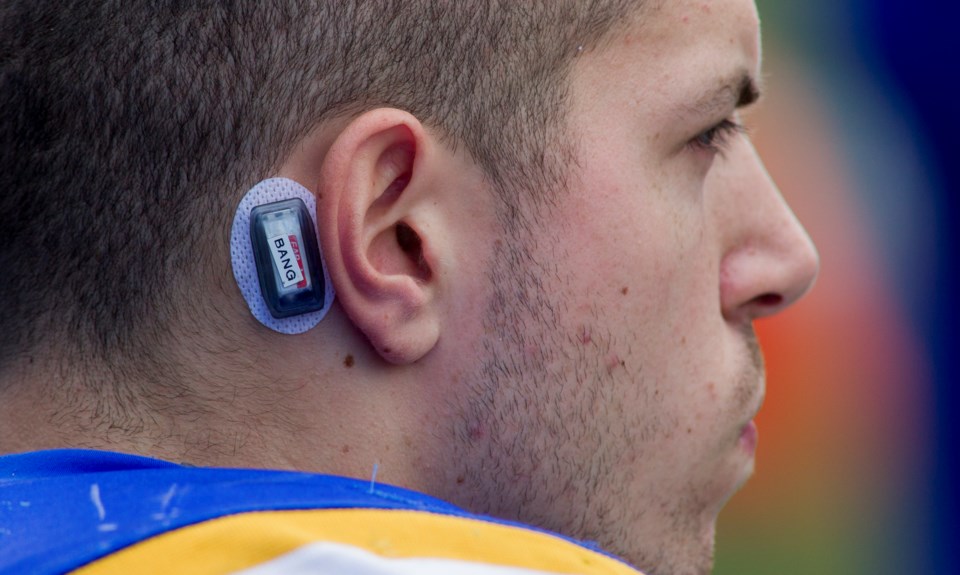In the second half of this yearâs Vanier Cup between the UBC Thunderbirds and the Université de Montréal Carabins football teams, UBC running back Brandon Deschamps took the football. He immediately found space, juked right and then ran around Montrealâs defence. It went into the books as a 44-yard touchdown run, a highlight in a 26-23 win for the underdog Thunderbirds. Less than a month later, right around Christmas, Deschamps signed a contract with the CFLâs Saskatchewan Roughriders.
The season didnât start so promisingly, however, as Deschamps suffered a concussion in the first game of the year against rival Calgary. He was pulled from the contest and had to miss the next start.
âI knew right away it wasnât good,â Deschamps recalls. âI didnât feel right.â
Deschamps had been wearing a concussion sensor behind his ear since the start of the 2014 season; a decision that he says was tough at first.
âAt first, I was apprehensive,â he says, in a soft voice not expected from someone nicknamed âBanger.â
âYou donât really want to know whatâs happening. The more I thought about it, I decided that the best we can do, anything we can to help younger players and educate them, it should be done.â
Field test
Of course, Deschamps wouldnât have the option of wearing a sensor if it werenât for Harrison Brown. Currently a PhD candidate, Brown was doing his Masters of Science at UBC when he and his lab partners developed the sensors. âBasically we know the number of hits each of the players take, and the magnitude of the hits,â Brown says in a Kitsilano coffee shop. âIf somebody gets concussed during the game, we test them on 10 different tests. But weâre also looking for things where people maybe arenât diagnosed as concussed, but they take really big hits or a lot of hits and we can see something through data that maybe gives us some more information.â
While he was working on the sensors, Brown was also taking a graduate business class. The class demanded that the students break into groups and start their own business. Brown doubled down on the concussion issue, and he and group member Kerry Costello started HeadCheck Health in 2013 with the help of the Entrepreneurship@UBC program. But it was only recently, to coincide with the release of the Hollywood film Concussion starring Will Smith, that HeadCheck announced a cellphone app designed to help doctors and trainers better diagnose concussions on the sidelines.
The traditional method of testing concussions has, according to Brown, some faults. âOne of the things we figured out was thereâs this balance test that they currently use to assess concussions, which is very poorly graded â itâs currently graded by humans,â says Brown. âFor example, if you were concussed, I, as a trainer or doctor, would say, âCan you stand on one foot?ââ
With Brownâs research, combined with the HeadCheck Health app, sensors test the athletes and provide baseline and post-injury results, which can then be easily uploaded to the app on the go, eliminating the previous system of human testing and carrying around two pieces of paper â one of the baseline test and one to test for a concussion â constantly. âWhat happens with that, is that the athletic trainer doesnât have an easy experience,â says Costello, sitting across from Brown. âTheyâre jumping from a piece of paper to a computer, to a mobile app back to a piece of paper, theyâre trying to track it all and keep it all in one place. That came through loud and clear in our initial interviews with customers â they didnât want that, they wanted one tool that made their lives easier.â
No-brainer
For Thunderbirds football head coach Blake Nill, the decision to allow the research to be a factor in the lives of his players was a no-brainer.
âI agree to allow it to continue because we have to know as much as possible,â Nill says. âThis is something I think is very important. UBC is a very progressive school, and itâs good that these things are happening, it helps all sports, not just football. As coaches we have to step up and be leaders.â
As much as the issue has presented Brown and Costello with a business opportunity, itâs also a personal story for the two. Brown, while born in Canada, moved to Hong Kong at the age of nine and ended up playing for Hong Kongâs national rugby team and suffering three concussions, including a particularly bad one. Costello balances the business with coaching girlsâ basketball at Magee secondary school, a task that Brown also helps with.
With 31 sports teams across the country using the HeadCheck app, including two Western Hockey League teams â the Victoria Royals and the Edmonton Oil Kings â the two seem destined for the big leagues. And theyâll go there, but itâs not their main priority.
âThe end goal is to take it to the kids,â says Costello. âThat is a huge opportunity for us because we have the ability to step in there that could actually prevent a lot of the deaths and serious injuries that could happen as a result of athletes going back in the sport too soon, so thatâs the dream.â
@ncaddell



